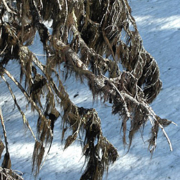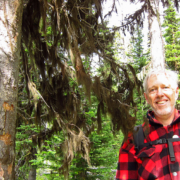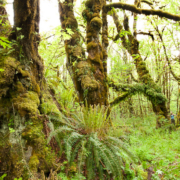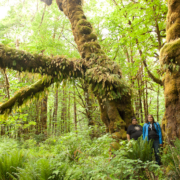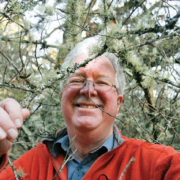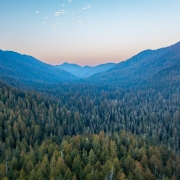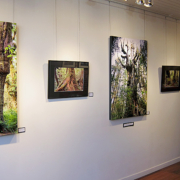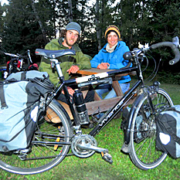Conservationists with the Ancient Forest Alliance (www.ancientforestalliance.org) on Vancouver Island have come across what they are calling “Canada’s Mossiest Rainforest”, a forest of enormous old-growth bigleaf maple trees – some up to 2.5 meters (8 feet) wide – completely draped in gardens of mosses and ferns. Unlike other spotlighted old-growth forests in British Columbia that have all been “coniferous” or needle-leaf trees (fir, cedar, spruce, etc.), this is an old-growth “deciduous” or broad-leaf forest. The “Mossy Maple Rainforest” is found near Cowichan Lake on southern Vancouver Island in Hul’qumi’num First Nations territory.
See an incredible photogallery of the “Mossy Maple Rainforest” at:
https://16.52.162.165/photos-sub.php?sID=2
Within the “Mossy Maple Rainforest” are two different old-growth stands several hundred meters apart, surrounded by second-growth maples, red alders and conifers:
– The “Mossy Maple Grove” is the densest and mossiest old-growth stand with specimens up to 2.5 meters (8 feet) in trunk diameter. It is also nicknamed “Fangorn Forest” in reference to the ancient deciduous forest in the second “Lord of the Rings” series. It is located on private forest lands that until recently were owned by TimberWest until the company sold its private lands last summer to two public sector pension funds, the BC Investment Management Corporation (BCIMC) and the federal Public Sector Pension Investment Board (PSPIB), without consulting the local Hul’qumi’num First Nations. The luxuriant understory is filled with a large diversity of herbaceous plants, and is frequented by elk and bears.
– The “Mossy Maple Gallery” is a more open, park-like stand of scattered giant maples and some enormous cedars and Douglas firs growing on Crown lands north of Mossy Maple Grove. Giant Devils Club with their brutally spiny stems, and legions of elk, deer, wolves, cougars, and black bears make this area home as evidence by their abundant tracks and scat. This area is known to local hunters.
“This type of forest is new to most conservationists and to the general public, few of whom are aware of old-growth deciduous rainforests. It’s sort of like spotting a woolly rhinocerous among a regular herd of endangered rhinos,” stated Ken Wu, Ancient Forest Alliance co-founder. “Bigleaf maples support First Nations cultures, abundant wildlife, salmon streams, BC maple syrup, and important scenery. The last ancient stands must be protected.”
The Mossy Maple Rainforest is in the unceded territory of the Cowichan people who are part of the Hul’qumi’num First Nations group ( https://www.hulquminum.bc.ca/).
“Our culture and our identity as Hul’qumi’num people are tied to our land. The large scale clearcutting on our unceded territories is an assault on our culture and on our human rights,” stated Hul’qumi’num Treaty Group chief negotiator Robert Morales. “The Hul’qumi’num land use plan calls for the protection of the last old-growth remnants in our territories. The BC government failed to consult with us regarding the sale of TimberWest lands to the two pension funds and they still refuse to negotiate compensation for the give-away of over 80% of our territories to private interests through the E&N land grant over a century ago.”
Currently there are no known logging plans – nor protective designations – for either of the two old-growth maple groves. Old-growth bigleaf maples are highly sought after by the logging industry for their extremely strong, dense wood, and most old-growth stands are now long gone.
“Bigleaf maples because of their hard wood was used by our people to make many things, especially paddles, while the large variety of understory plants are still used for many types of medicines and foods. The herds of elk and the remaining salmon have always been vital foods to our culture,” stated Arvid Charlie, an elder with the Cowichan Tribes with an extensive knowledge of the traditional uses of plants and resources.
In recent years farmers and woodlot owners on Vancouver Island have begun tapping bigleaf maples for their syrup, which is milder and different in flavour than syrup from sugar maples in eastern North America. Currently demand for BC maple syrup far surpasses the supply.
The Ancient Forest Alliance is calling on the BC government to protect BC’s endangered old-growth forests through a Provincial Old-Growth Strategy and through implementing First Nations land use plans, and to ensure the sustainable logging of second-growth forests. To protect old-growth bigleaf maples on private lands, the government needs to allocate funds to systematically buy up these stands for conservation purposes.
“These ancient maple rainforests are some the mossiest and awesome – or ‘mossome’ as we like to say – forests on Earth. If done sensitively, they could support a significant eco-tourism and cultural tourism industry that would benefit the local economy, much as the famous bigleaf maple rainforests of the Hoh Valley in Washington’s Olympic National Park do,” stated TJ Watt, AFA co-founder and photographer.
BACKGROUND INFO on BIGLEAF MAPLES
Bigleaf or broadleaf maples (Acer macrophyllum) can grow to 3 meters (10 feet) in trunk diameter and to over 300 years old, making them among the largest deciduous trees in the temperate world. Most old-growth bigleaf maple stands have been logged over the past century, along with the original giant Sitka spruce that they often grow with along rivers and streams.
Bigleaf maples are naturally found along the lower elevation rivers and streams of Vancouver Island and the southern Mainland coast, in many cases on private lands. They naturally grow on old river terraces along streams and rivers and other naturally disturbed sites in wet areas and are sometimes succeeded after several centuries by taller conifers – Sitka spruce, redcedar, western hemlock, Douglas fir.
In recent years, some Vancouver Island farms and woodlots, particularly in the Cowichan and Comox Valleys, have begun tapping bigleaf maple stands to make BC maple syrup, which could become an economic incentive to keep bigleaf maples groves standing. Currently the demand for bigleaf maple syrup far outstrips the supply.
Logging of conifers can assist the spread of second-growth bigleaf maples up slopes and mountainsides in areas where they would normally be at a competitive disadvantage to conifers. Old-growth bigleaf maples tend to be found at lower elevations on flatter land and near streams and rivers where they established themselves long before European colonists arrived.
Bigleaf maple wood is heavily sought after for making furniture and musical instruments, and bigleaf maple commercial logging and even tree poaching is a common problem in BC.
Their bark is ideal for the growth of diverse mosses, licorice ferns, and lobaria (“lettuce”) lichens, harbouring more “epiphytes” (plants growing on trees) than any other trees in North America.
Over time soil accumulates underneath the decomposing mosses and ferns on the tree branches. Researchers in the 1980’s discovered that the maples actually send aerial roots from their branches into these canopy soils to tap the extra nutrients!
Bigleaf maple groves often have rich soils that support a luxuriant and diverse understory layer of herbaceous plants and shrubs, giving some stands a semi-tropical feel in summer time.
The edible young maples, shrubs and diversity of herbaceous plants often attract elk and deer, and hence their predators, cougars and wolves.
Bigleaf maples provide shade, woody debris, leaf litter nutrients, and stream bank stabilization that help to support salmon and trout.
Bigleaf maple wood was used by coastal Salish people to make paddles, spindle whorls, bowls, spoons, hairpins, combs, adze handles, cedar bark shredders, and fish lures (Plant Technology of First Peoples in British Columbia, Dr. Nancy Turner, 1998) while the large variety of understory plants are used for numerous medicines and foods.

